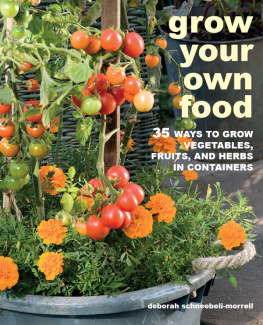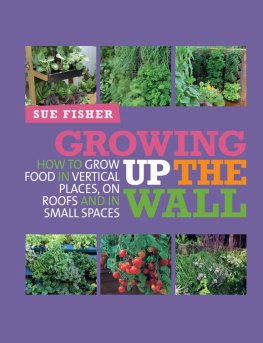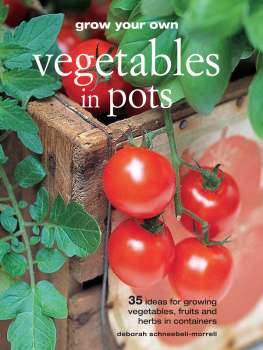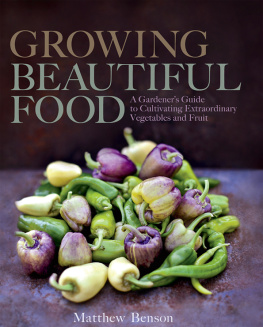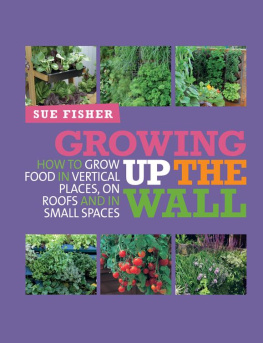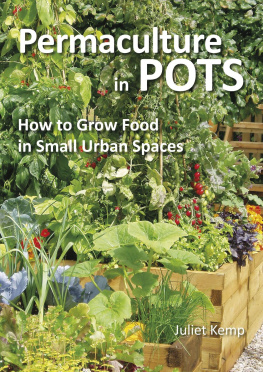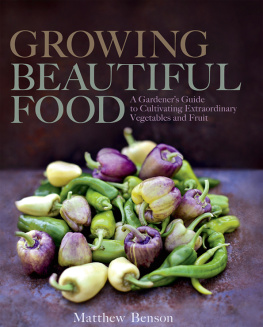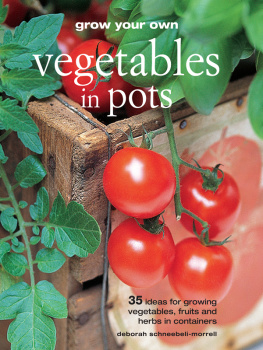How to grow
your dinner
without leaving
the house.
Claire Ratinon
Laurence King Publishing
How to grow
your dinner
without leaving
the house.
Published by Laurence King Publishing Ltd
361373 City Road
London EC1V 1LR
Tel: +44 (0)20 7841 6900
Email:
www.laurenceking.com
Text 2020 Claire Ratinon
Claire Ratinon has asserted her right, under the
Copyright, Designs and Patents Act 1988, to be
identified as the author of this work.
All rights reserved. No part of this publication
may be reproduced or transmitted in any form or
by any means, electronic or mechanical, including
photocopy, recording, or any information storage
and retrieval system, without prior permission
in writing from the publisher. Every reasonable
attempt has been made to identify owners of
copyright. Errors or omissions will be corrected
in subsequent editions.
A catalogue record for this book is
available from the British Library.
ISBN: 978-1-78627-941-5
Commissioning editor: Zara Larcombe
Photography: Ida Riveros, Rita Platts and
Claire Ratinon
Design: Masumi Briozzo
Printed in China
A Note on Plant Varieties:
We have included a range of varieties within our
Plant Profiles, but not all of these will be available
worldwide. However, the principles discussed in
each profile will still apply and allow you to grow
happy and healthu produce.
Laurence King Publishing is committed to
ethical and sustainable production. We are
proud participants in The Book Chain Project
bookchainproject.com
Contents
As an urban dweller who discovered her love
of plants while living in a one-bedroom at with
no outside space at all, Im familiar with the
overwhelming urge to grow vegetables without
a garden. My journey from documentary
filmmaker to urban food-grower has seen
me growing plants wherever I could find the
opportunity: from raised beds in East London
primary schools to a summer spent taking care
of thousands of potted plants on a disused
car park, and from installing pollinator-friendly
planters in Tube stations to growing organic
salad on a tiny site in Hackney. When youre
determined to grow plants in a city, you make it
happen wherever you can!
I honestly believe that if you want to grow
your own, it is possible. Even in the city, even
without a garden, even if your outside space
is tiny and paved over. You might not achieve
self-sufficiency, but you can experience the
pleasure of nurturing a seed into a plant
that ends up on your plate. It is a simple but
humbling process. Its not always easy, but it
neednt be too difficult if youre up for learning
how to give a plant what it needs to survive,
and thrive, in a pot.
Growing plants has led me to more than just
delicious fresh produce. It has been a gateway
to better mental and physical health. It has
allowed me to access a deep gratitude for all
those who have a role in growing our food, and
it has enabled me to connect with the natural
world that supports us and with the seasons
through which we move every year. Most
importantly, it has prompted me to cultivate an
ever-expanding awareness of the systems that
feed us, and to do my best to tread as lightly
on our extraordinary Earth as I can. That is why I
grow my plants following organic principles, an
approach that respects and honours the many
natural systems that make it possible for plants
to grow for our benefit and nourishment.
My sincerest hope is that, through this book,
youll feel encouraged to explore the joy of
growing vegetables for your dinner and all the
other wonderful things that adventuring with
plants can bring.
Why grow your own food?
GETTING
STARTED
The basics
Light
Theres no green plant that can live without the
light of the sun. Photosynthesis is the process
whereby a plant takes sunlight, carbon dioxide
and water and turns them into energy to grow.
This magical process is foundational for the
existence of all living things.
Water
Water is necessary for photosynthesis, for
moving minerals, nutrients and food around
the plant, and for enabling the plant to stand
upright. Although all plants need water, its
worth noting that all have different needs, and
too much can be as bad as too little.
Temperature
Plants, like all other living things, respond to
the temperature of their environment and
as is the case with light and water different
plants need different conditions to thrive.
Each plant has an optimal soil temperature for
germination, an ideal temperature for growth
and a minimum temperature for owering,
fruiting and ripening.
Growing medium
All the plants that youll be growing to eat need
something to grow in, and, since in this book
were not talking about growing in garden
soil, thats going to be compost. The growing
medium is essential for holding the water and
nutrients a plant needs to absorb through its
roots, for having the right structure for roots to
anchor into for stability and for holding pockets
of air so that the roots can breathe.
Pollination
If the edible part of the plant youre growing
is a fruit, its ower will need to be pollinated
to transform it into that fruit. Different plants
have evolved alongside their ideal pollinator
whether bees, butteries, beetles or wind
but in their absence, it is possible for us to
intervene to ensure that our plants produce a
bountiful crop.
Understanding what a plant needs in order to
ourish is vital if you want to grow your own.
Edible plants need more of your attention
and awareness than houseplants if they are to
produce deliciousness for your plate.
VIOLA TRICOLOR
VIOLA
Annual vs perennial
I remember how confusing I found these two
words when I started learning about plants, but
its really useful to get your head around them.
Annual plants have a life cycle that goes from
seed to harvest in less than a year (sometimes
only a month or two). Perennials, on the other
hand, can live for several years because they
have the physical make-up to survive through
all seasons even if they hibernate or die back
in the winter, they will start to grow again when
the weather warms up. Most of the plants in
this book are grown as annuals, so its probably
not worth trying to nurse them through the
winter in the hope that theyll grow again the
following year (although I have known people
to do this!), because they will be very, very sad.
GETTING STARTED
/ THE BASICS
The best part of container growing is how


